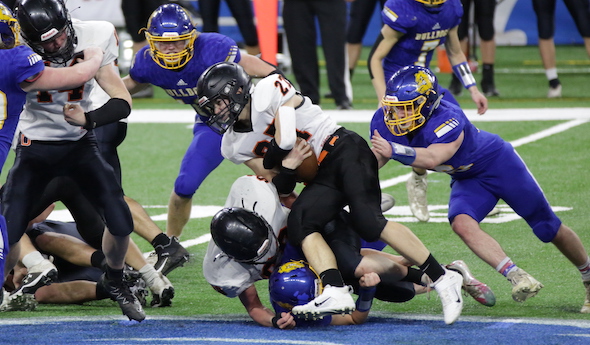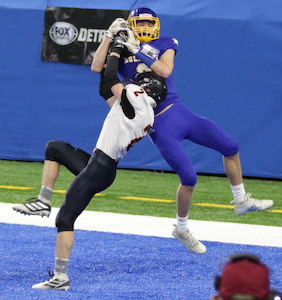
Inside Selection Sunday: Mapped Out
October 19, 2012
By Geoff Kimmerly
Second Half editor
NOTE: This originally was published Oct. 24, 2011, after selection of last season's playoff field. It's an explanation of how the MHSAA creates the playoff pairings for its football tournaments, a delicate task we will undertake again Sunday.
Sitting on the other side of this process for a number of years, I can admit to occasionally scratching my cynical head over some of the matchups that have come out of Selection Sunday.
How could teams so far from each other play in the same district? Why would two schools in the same town play in different regionals? Are they picking out of a hat at 1661 Ramblewood Drive?
Now, I have answers.
Sunday morning, we filed into headquarters for what might be the most important non-game day on the MHSAA calendar. “We” were made up of half of the MHSAA staff, plus a representative from the Michigan High School Football Coaches Association.
Here’s some of what I learned from being a part of the process:
- First, a brief history lesson. In early years (or until the middle of the last decade), lines were drawn by hand. Dots representing qualifying schools were pasted on maps, one map for each division, and those maps were then covered by plastic sheets. Districts and regionals literally were drawn with dry-erase markers. No longer. Using a variety of spreadsheets and mapping software, we’ve gone digital. Staff is split into two teams, each considering four divisions (and the 8-player map) before we reconvene and look at all nine divisions together.
- We are presented digital maps of the state covered in dots. That’s about it. The rule of the day, simply, is “geography rules.” Which teams are represented by the dots is not considered, much less discussed, until lines are drawn. While considering my group’s first map, I began to bring up teams – and immediately was shot down (with good reason). Teams, matchups, rivalries, previous playoff pairings, etc. DO NOT come into play. We draw boxes in what we figure are the most logical ways of making districts and regions work.
- Travel distance and ease DO come into play. This especially is true when considering which districts will include teams from the Upper Peninsula. An example: Marquette is closer to the schools we placed in its district – Fenton, Bay City Western and Okemos – than some other options because those schools are closer to I-75. Schools further north on the map but farther from a main highway would’ve created longer trips.
- Sometimes, maps get ugly. And sometimes, it was a matter of choosing the least ugly situation. Of course, a Division 4 District of Lansing Sexton, Dearborn Heights Robichaud, Battle Creek Pennfield and Vicksburg isn’t ideal. But with no other Division 4 schools within 35 miles of Lansing, we were put in a tough spot. Add in that there were 13 teams in the Detroit area, leaving one as the odd team out of three districts based there. Something had to give, and drawing things up as we did caused the fewest messes.
- Considering how to set up the entire state is different than figuring out what teams make the most sense for just one school or area. And shifting just one dot on a map can change things for all 32.
- Back to “geography rules.” The Division 8 district including Saugatuck, Muskegon Catholic, Mendon and St. Joseph Lake Michigan Catholic might be the most competitive, on paper, in the state. Saugatuck is the reigning MHSAA runner-up in the division, and Muskegon Catholic and Mendon were ranked Nos. 1 and 2, respectively, in the most recent Association Press poll. Seeing that after we’d drawn the line caused a collective “ouch.” But again, the line was drawn based on dots on a map.
I thought back on some of the matchups I’d questioned in the past, and came back to what I’d ask people now: How would you do things differently?
I imagine there would be some creative answers, but I also would guess we considered those scenarios too.
And remember, determining the playoff schedule is just one step in many. Eight state champions must survive it, regardless of which opponents they face along the way.

'D' Propels Centreville to 1st Finals Win
By
Paul Costanzo
Special for MHSAA.com
January 22, 2021
DETROIT – It didn’t take long Friday for the Centreville defense to prove its season statistics were no fluke.
The Bulldogs stuffed Ubly on a 4th-and-short at midfield on the first possession of the MHSAA Division 8 Football Final, setting the tone for a dominant performance in their 22-0 victory at Ford Field.
“The defense played hard today,” Centreville senior defensive end and fullback Jared Spencer said. “I think we went all out – our seniors went all out just because it was our last game. Our first time making it to state, so I just think our defense, we were ready for the game.”
The title is the first for the Bulldogs (11-0), who had never won a District title in the sport prior to this season. While it didn’t look like it to those observing, coach Jerry Schultz said the nerves were certainly there pregame.
“If they’re going to say (they weren’t nervous), then they’re lying,” said Schultz, who is in his first year leading the program. “I could see it on their faces that they were nervous, especially this morning. That’s why we got on the field so early … we went and ran routes, I wanted them to just throw the ball around. As we told them, it’s 100 yards. Even I walked out here – I've never been here before, I’m actually a Packer fan – but just walking out here, it’s awesome.”
The 11 wins are a school record, despite the regular season being shortened by three games. The program was in the postseason for the third straight year, but just the seventh in school history.
“All the offseason work in the weight room and all the conditioning – everything that we had done since we were freshmen, it’s the best feeling to have to come in as a senior (and win) with this group of guys,” senior quarterback and safety Sam Todd said. “So, coming out on top as a senior, it doesn’t get better than that.”
Centreville was dominant throughout the year, with only two of the 10 games it played – its Semifinal was won by forfeit over Clarkston Everest Collegiate – being decided by single digits. That effort was led by a defense that had seven shutouts and allowed 29 points on the season.
“Just buying into the defense,” Spencer said when asked to explain the success. “It’s been the same defense since (defensive coordinator Trevor Haas) has been here. We’ve had the same players since freshman year, so I think we just had that bond to keep it tight.”
The Bulldogs held Ubly (9-3) to 142 yards of total offense, but 103 of those came on second half possessions when they had already built a 22-0 lead. Ubly was held to 24 yards in the first half, and didn’t record a first down until there was 3:54 to play in the third quarter.
 Jacob Spencer led the Bulldogs defense with 10 tackles, while Ethan Brownridge had seven. Tristan McElroy had an interception in the end zone, which ended Ubly’s best drive of the day.
Jacob Spencer led the Bulldogs defense with 10 tackles, while Ethan Brownridge had seven. Tristan McElroy had an interception in the end zone, which ended Ubly’s best drive of the day.
“One thing that they do is they have that angle front,” Ubly coach Eric Sweeney said. “Four years ago, (former Centreville coach) Tyler Langs coached at (Unionville-Sebewaing) and they’re still running his defense. So, it’s not something we haven’t seen, but we knew it was going to be tough because when you’re trying to run a trap and they’re angling those guys up front, you have to do some different things. They flew to the ball. Their linebackers came downfield. It was nothing we didn’t expect, but I kind of thought we’d block it better, but we didn’t. I thought they played incredible defense.”
When the Centreville defense wasn’t on the field stifling the Bearcats, the offense was giving it plenty of rest. The Bulldogs’ ball-control attack chewed up clock, with nearly 30 minutes of possession to Ubly’s 18. They ran the ball 42 times for 156 yards, and made big plays in the passing game when needed, as Todd was 6-for-7 for 130 yards and a pair of touchdowns, both to junior receiver Tyler Swanwick.
Todd also led the Centreville rushing attack with 70 yards and a touchdown on 19 carries.
“I think our biggest problem like I was saying before, we like to play ball-control offense, and that’s what they did,” Sweeney said. “When they needed a big play, they got it. When we only run 10 plays in the first half, that’s not ball-control offense. Personally, I thought our defense played very well, but our defense never got rest, because we played bad offense. We knew (Todd) was an excellent football player. There were no surprises there.”
Todd’s first score came on a 1-yard run midway through the second quarter. The fourth-down play was nearly blown up in the backfield, but Jared Spencer had a big block to help his quarterback get the edge.
Swanwick made a pair of big plays on the second scoring drive, catching a deflected pass for a 31-yard gain, setting his team up at the 20-yard line with nine seconds to play in the half. On the next play, Todd found his top target with a well-thrown jump ball in the end zone, and the Bulldogs took a 16-0 lead into the half.
The Bulldogs all but put the game away with their first drive of the third quarter, eating up 7:46 on the clock, and finishing the drive off with a 12-yard pass from Todd to Swanwick.
Carson Heleski led the Bearcats in his final game, recording 16 tackles, including 1.5 for loss. He also had a team-high 67 rushing yards.
PHOTOS: (Top) Centreville defenders swarm around Ubly running back Mark Hellig during Friday’s Division 8 Final. (Middle) Centreville’s Tyler Swanwick pulls in one of his two touchdown catches. (Click for more from Hockey Weekly Action Photos.)

